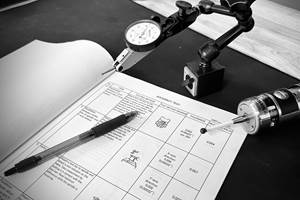CAD-Based Measuring Software Handles Large Complex Parts
Many CMMs today are outdated with respect to the needs of today's quality standards and production requirements. In most cases, the original CMM machine hardware has the built-in precision to accurately provide the ongoing sophisticated measuring demands. The problem is that the software and even most of the upgrades provided with the original machines may not be adequate.
Share






Many CMMs today are outdated with respect to the needs of today's quality standards and production requirements. In most cases, the original CMM machine hardware has the built-in precision to accurately provide the ongoing sophisticated measuring demands. The problem is that the software and even most of the upgrades provided with the original machines may not be adequate. No longer do users merely want to know if a part is good or bad; they need information for adaptive and process control. They need to take measured data and integrate it with CAD data to compare the theoretical data with actual data.
To meet this need, Paragon Die & Engineering (Grand Rapids, Michigan), a designer and builder of large plastic injection molds for the automotive and truck industry, upgraded its existing gantry CMM machine with Virtual DMIS software from International Metrology Systems, Inc.
Paragon uses the CMM, a 1989 Delta model from DEA, to verify the accuracies of the mold surfaces and features. Both molds and parts are certified to customer specifications. The CMM is large enough to fit an entire car body under the column. Inspection on the CMM is an essential part of the mold making process. CAD/CAM systems accept 3D surface or solids information via modem or tape. The electronic transfer of data from determining part feasibility to the review and approval of mold design is one of Paragon's standard procedures. CAM capabilities have allowed total construction of complex tools without models or aids such as plastic fender tools and bumper tools. This capability and technology has provided major reductions in tool leadtime.
"We selected to upgrade to Virtual DMIS because it matched the needs of the type of complex molds we build for the automotive industry," says Rick Kerkstra, Paragon quality control manager. Having the ability to generate inspection data directly from an imported CAD model is paramount to the expediency and accuracy of our mold production. We wouldn't be able to inspect without the 3D model."
According to Mr. Kerkstra, the new software enhances the shop's capability to
- provide bi-directional data transfer between CAD and CMM
- accept nominal surface model data from CAD data
- provide error calculations with respect to patch, curve or trimmed edges
- supply graphical representation of actual versus nominal data
- provide automatic alignment and "Best-Fit" routines
- give reverse engineering data with the ability to export to CAD directly
- generate 2D sections from 3D surfaces
"Of course, the ease of use and the editing capability is of particular benefit to our technicians," Mr. Kerkstra adds. "For once, you can actually understand and determine what DMIS code is really saying. It's very easy to train new operators because they can see and understand the inspection concepts better."
According to Chris Kladder, Paragon CMM operator, "The menus are user friendly, and it's very useful to see the solid model. Having mirror-imaging capability is also a plus. Many of the molds we make are symmetrical, so programming is greatly reduced. We can take a very complicated large die today and completely inspect it in 8 hours."
"One other point that should to be mentioned is the need for good customer support when undertaking an upgrade like this," Mr. Kerkstra notes. "Our CMM is the one of the most important activities in our mold making process. We can't afford downtime either mechanically or functionally, and that certainly focuses on the software."
Virtual DMIS is available for any make, type or size of CMM. The software includes error-correction, which is said to enhance the machine accuracy. Built-in machine accuracy checking routines include Ball Bar, Step Gage and Length Bar. Retrofit programs for both manual and CNC machines are also available.
Related Content
4 Ways to Establish Machine Accuracy
Understanding all the things that contribute to a machine’s full potential accuracy will inform what to prioritize when fine-tuning the machine.
Read MoreThe Many Ways of Measuring Thickness
While it may seem to be a straightforward check, there are many approaches to measuring thickness that are determined by the requirements of the part.
Read MoreThe Link Between CNC Process Control and Powertrain Warranties
Ever since inventing the touch-trigger probe in 1972, Sir David McMurtry and his company Renishaw have been focused on achieving process control over its own manufacturing operations. That journey has had sweeping consequences for manufacturing at large.
Read MoreBallbar Testing Benefits Low-Volume Manufacturing
Thanks to ballbar testing with a Renishaw QC20-W, the Autodesk Technology Centers now have more confidence in their machine tools.
Read MoreRead Next
How I Made It: Dennis Rymanowski
Dennis Rymanowski has worked at NSH USA for 60 years, with his passion for manufacturing living alongside his passion for his family’s polka band.
Read MoreA New Frontier in Surface Finish Control
What if your machine tool could measure surface roughness as it cuts? This article explores how in-process metrology is advancing from concept to reality, enabling real-time feedback, immediate detection of anomalies and new levels of control over surface quality. Discover the technologies making this possible.
Read More





















